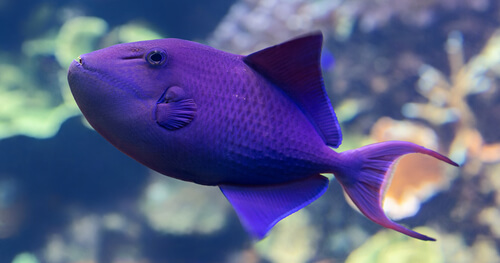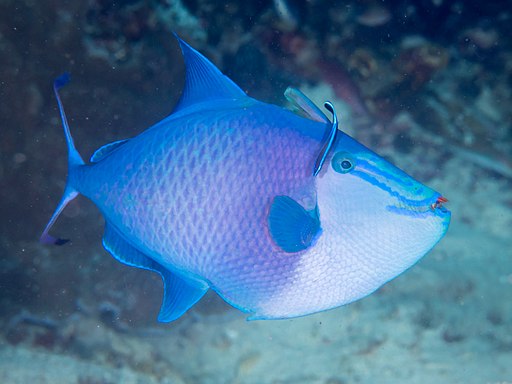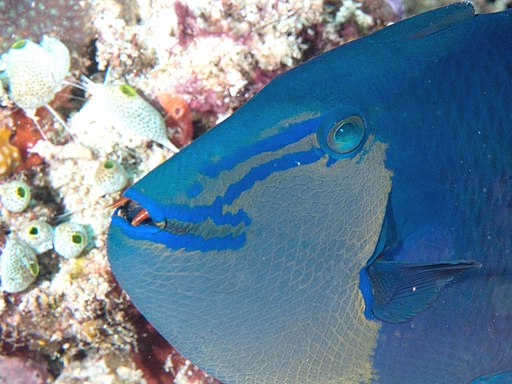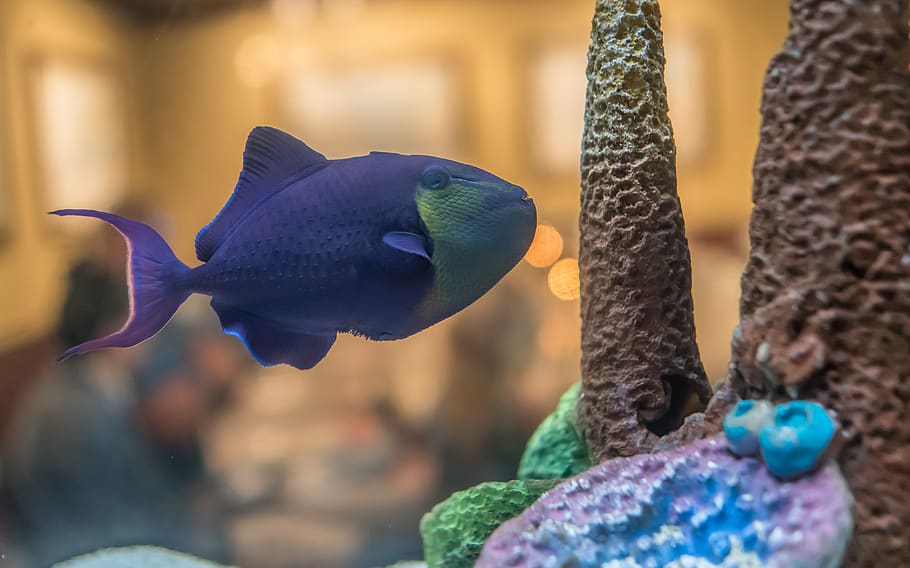Niger Triggerfish: Care, Tank Mates, Tank Size & More
Posted by on 4/13/2023
We use affiliate links and may receive a small commission on purchases.
The Niger Triggerfish, also known as the Redtooth Trigger, is a powerful, aggressive species capable of producing sounds and changing color on a whim. While it's easy to understand why hobbyists would want to pursue such a unique-looking fish, the species' aggressive personality and large size require specific care requirements that must be met for this fish to thrive.
In this post, we'll cover everything a hobbyist will need to know to decide whether or not a Niger Triggerfish should be your next tank addition. We'll discuss the fish's reef compatibility, recommended tank sizes, and much more.
January's Giveaways on Light Fish
Species Summary
The Niger Triggerfish (scientific name: Odonus niger) is one of the most interesting fish in the world's oceans. The species can be found hiding among the rocks near the reefs of the Indo-Pacific, where it feeds primarily off of zooplankton and microcrustaceans.
The species is perhaps best known for three distinct features. Its red teeth (which is how it earned the Redtoothed triggerfish common name), its color-changing ability, and its large dorsal and anal fins, which it uses to swim and position itself in the water column.
Scientifically classified by German naturalist Eduard Rüppell , the fish lives up to 100 feet below the surface and reproduces at designated mating areas established by the male species. In the wild, the fish can be found in large groups. Interestingly, the species is also the only member of its genus.

Appearance
The Niger Triggerfish is an attractive-looking fish. Its small mouth features fang-like red teeth that are exposed even when the mouth is shut. The front half of the fish is topped by three dorsal fin spines, giving the fish a more vertical appearance. The rear half of the fish features large anal and dorsal fins that taper to a lyre--shaped tail.
The color of the fish can change depending on the fish's mood, lighting spectrum, and other environmental factors. Hobbyists can expect the fish to exude different shades of blues, purples, and greens, and may also notice an electric blue coloration outlining the fish's fins.

Juvenile vs Adult
Juvenile Niger Triggerfish will appear much smaller than their adult counterparts but will feature similar coloration.
While adult juveniles may only be a few inches in length, they'll reach their adult size at about 2 years of age.
Male vs Female
Males and females look identical, and the only surefire way to notice the difference is by observing a pair-up in the wild.
Similar to other species of fish, if these fish successfully breed, only the female will tend to the eggs.
Size
Adult Niger Triggerfish can grow to be quite large and will reach about 12 inches in length.
Providing the fish with a nutrient-rich diet, and a pristine environment will improve their ability to grow to a healthy adult size.

Niger Triggerfish Care
Luckily for hobbyists interested in pursuing the species, the Niger Triggerfish isn't particularly difficult to fish to care for. It shares similar requirements as many other types of marine fish.
As long as you can manage its aggressive behavior, and provide it with a large enough aquarium, it can live a full life in an at-home aquarium.
Lifespan
Similar to other species under the family Balistidae , the Niger Triggerfish has a life expectancy of about 10 years.
Hobbyists should feed the fish regularly, and should frequently test their aquarium water using a reliable testing kit .
Tank Size
Due to the Niger Triggerfish's large size and aggressive temperament, you'll want an aquarium that's at least 180 gallons in size.
For many aquarists, having such a large aquarium will be the biggest barrier to entry for owning a Niger Triggerfish, but keep in mind that larger aquariums do tend to be a bit more stable, a nice perk for those considering such a large ecosystem.
Acclimation
Niger Triggerfish should be drip acclimated, using a drip acclimation kit , so that the fish's transport bag conditions slowly align with your display tank's temperature and salinity levels.
If possible, we advise first acclimating the fish to an established quarantine tank, so that you can monitor the fish carefully for 6 weeks. These fish are wild-caught and may contain harmful bacteria that can spread to other inhabitants in your display tank.
Water Conditions
Hobbyists will want to recreate the water conditions of the Indo-Pacific as closely as possible in their display tanks.
Aim for maintaining the following water parameters:
Ammonia: 0ppm
Nitrite: < .2ppm
Nitrate: < 10ppm
Specific Gravity: 1.020-1.025
Temperature: 72°F-78°F
dKH: 8-12 dKH
pH: 8.1-8.4
Salinity levels can be measured with a test kit , and pH levels via a pH meter .

Tank Setup
Once you've settled on an appropriately sized tank, you'll want to provide plenty of live rock for your Niger Triggerfish. You'll want to re-create small caves and caverns for them to swim through, similar to what they experience in their natural habitat.
These triggerfish aren't very demanding when it comes to flow, and prefer to swim outside of the current. Providing a sump with a refugium is recommended, as both will increase the volume of water in your ecosystem, resulting in more stable water parameters.
While it's not required, a crushed coral substrate would be preferred over a bare-bottom tank, which more closely resembles the coastal areas from which they're from.
Common Diseases
The Niger Triggerfish has a long, delicate, lyre-shaped tail, and when exposed to poor tank conditions, can easily suffer from fin rot. You'll need to stay on top of your water chemistry to retain the fish's attractive appearance.
Other common diseases include marine ich, which typically appears as small white dots that cover the body of the fish, and marine velvet, which appears as a powder also along the fish's body. While we won't get into treatment options in this post, we discuss the topic in further detail in a related blog post: Marine Velvet vs Ich: Similarities, Differences, Causes & Treatment.
Food & Diet
The Niger Triggerfish should be fed a diet consisting of clams, krill, squid, mysis shrimp, and shell-on raw shrimp 2-3 times per day.
These fish are big eaters and will need hard-shelled food to wear down their teeth. As omnivores, they'll also accept Nori but tend to have a preference for meat-based foods.
Behavior and Temperament
There are few marine fish that can compete with the unique behaviors seen with the Niger Triggerfish. The species is capable of changing colors for almost no reason. While mood and lighting may be a factor, it's been difficult to pinpoint the driving forces behind their frequent color changes.
The fish is also capable of producing a pig-like grunting sound when threatened, a trait also possessed by other species of Triggerfish.
These fish can be quite aggressive, but the Niger Triggerfish isn't as aggressive as some of the other triggers we come across in the marine hobby, such as the Clown, Blue-Lined, and Gray. When kept well-fed, they can be peaceful, just keep in mind that personality can vary between individual fish.
Niger Triggers tend to hang out near the bottom and middle of the aquarium water column, where they'll be on the move for new food sources. Using their red-colored teeth, the fish is also known to rearrange the substrate and small pieces of live rock.
Reef Compatibility
Although some hobbyists have risked keeping the niger triggerfish in a reef aquarium, the fish is not considered reef-safe.
Hobbyists brave enough to risk their corals and anemones will need to keep the fish well fed, a minimum of 3 feedings per day, to ensure they don't see your corals as a snack.
However, we think it's best to play it safe and avoid keeping them in a reef aquarium. A FOWLR (fish only with live rock) tank is best for the species.
Tank Mates
Hobbyists should choose Niger Triggerfish's tank mates carefully. Their aggressive personalities make them incompatible with many of the more common marine fish.
Potential tank mate options include:
Avoid highly aggressive species, such as the Tessalata Eel. Invertebrates should also be avoided, as the Niger Triggerfish will want to gnaw on their hard shells.
You'll also want to avoid adding other Triggerfish species, as a hierarchy will end up forming and fighting will be inevitable. You can reduce aggression by introducing the Niger Triggerfish as the last fish in the aquarium and by keeping your livestock well-fed in an appropriately-sized aquarium.
Breeding
There have been no successful attempts at breeding the Niger Triggerfish. All of the fish found in the hobby are wild caught, and have a Least Concern designation from the IUCN .
However, there may be some hope for captive-bred triggerfish in the near future. We've seen captive-bred clown triggerfish from Biota.
Where to Purchase
The Niger Triggerfish can occasionally be found for sale on our marketplace but also makes appearances in local fish stores and some of the larger online retailers, such as LiveAquaria.
Hobbyists looking to purchase the fish should inquire about the fish's current tank water conditions, as well as the age of the fish so that they can plan appropriately.
Conclusion
As you can see, the Niger Triggerfish has a ton to offer. Whether it's the fish's chameleon-like behavior or distinct appearance, it's easy to understand how the fish has become a favorite amongst hobbyists for decades.
Now that we've discussed the fish in detail, do you plan on adding one to your marine aquarium?
Let us know in the comments below, and be sure to visit our community forum and marketplace where you can buy, sell, and trade with other aquarium hobbyists.
January's Giveaways on Light Fish


